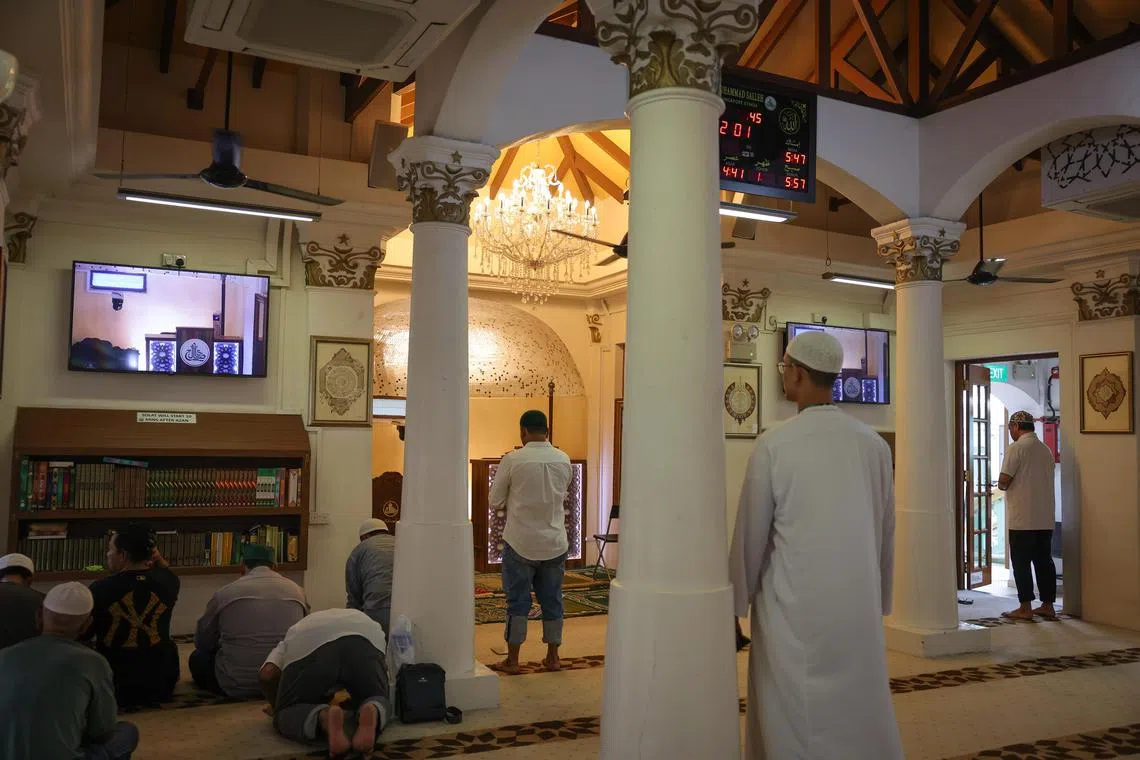Retrace steps of early immigrants in new Tanjong Pagar heritage tour
Sign up now: Get ST's newsletters delivered to your inbox

Seng Wong Beo temple was known for conducting ghost marriages in the past, but has stopped the practice now.
ST PHOTO: ONG WEE JIN
Follow topic:
SINGAPORE – Mysterious marriages for the deceased used to take place in Seng Wong Beo temple in Peck Seah Street in Tanjong Pagar.
Two paper doll effigies – representing the groom and the bride – would be offered food and presented with a paper house, complete with furnishings, from bereaved family members. The items would be placed on a paper bed at the end of the ghost marriage ritual, before being torched in an incinerator at the temple.
The temple had been carrying out this ritual, which cost about $1,000, for more than 100 years before it was stopped eight years ago.
A temple staff member, who declined to be named, said ghost couples were paired according to the cause of their death, for example, victims of miscarriages.
“Sometimes, the groom-to-be would even appear in a dream to tell his parents who he wanted to marry, and lead us to the address of the prospective bride,” she said, adding that some non-Chinese people also requested the service.
The 126-year-old temple is one of the highlights of the My Tanjong Pagar Heritage Tour launched by My Community, a non-profit organisation that champions community heritage.
The temple, founded in 1898, was frequented by early immigrants from China who mainly settled in Tanjong Pagar and Telok Ayer. It is unique for its traditional Chinese architecture that combines elements from both Buddhism and Taoism.
While the Provincial City God is the main deity housed in the temple, other deities such as the White Tiger General, Yama King and Azure Dragon are also worshipped there.
The new tour is the 16th heritage trail run by My Community, which has been organising free guided tours in various neighbourhoods since 2010, with the most popular ones in Tiong Bahru, Tanglin Halt and Alexandra.
Each tour can take up to 30 participants. There are about 30 tours, which are conducted in English, each month.
The Tanjong Pagar tour retraces the steps of immigrants who arrived here during colonial times, and visits landmarks reflecting Singapore’s success as a port and its growth to a First World nation.
Besides the temple, the trail includes Tanjong Pagar Plaza, home to several shops that have been operating for close to 40 years.
Mr Ronnie Ong, 73, is retiring in August after spending 44 years manning his shop, Quick Photo Distributor.
The complex used to be filled with textile merchants, goldsmiths and stationery shops, he said. Today, it is dominated by beauty services such as massage parlours and hair and nail salons.
“During the 80s, I could develop 500 rolls of film a day. I even had to work during Chinese New Year,” he said. “Today, I print only one or two photos a day, and mostly serve customers who want to have their passport photos taken.”

The shrine of Habib Noh is still visited by many worshippers today.
ST PHOTO: ONG WEE JIN
According to Mr Ong, the number of photo studios in Singapore dropped from around 900 to about 70 in the early 2000s, when digital photography became prevalent. There are fewer than 60 photo shops like his around the island today, he estimated.
The heritage trail also stops at Masjid Haji Muhammad Salleh, one of the oldest mosques in Tanjong Pagar. It has architecture that is a blend of European and Middle Eastern influences, and it houses the Keramat Habib Noh.

The interior of Haji Muhammad Salleh Mosque, whose architecture is a blend of European and Middle Eastern influences.
ST PHOTO: ONG WEE JIN
The shrine holds the tomb of Habib Noh, one of the most venerated members of the local Muslim community, who died in 1866 at the age of 78. He was known to have a great store of religious knowledge, and did good works for the community, such as helping the poor with food and shelter.
Mr Muhammad Alwardi Yacob, assistant administrative executive of the mosque, said: “The tomb is visited by busloads of Malaysian and Indonesian worshippers regularly, Muslim scholars from all over the world, and we even had a Taiwanese monk who dropped by once.”

Long-time shopkeeper Ong Eng Boon, or “Uncle Ronnie”, of Quick Photo Distributor in Tanjong Pagar Plaza.
ST PHOTO: ONG WEE JIN
Other highlights of the tour include Murray Terrace, a distinctive block of pre-war shophouses in Murray Street; the Monetary Authority of Singapore building; the Jinrikisha Station, which served as the main depot for hand-pulled rickshaws – Singapore’s most popular form of transportation in the 19th to early 20th century; and the former traffic police headquarters.
My Tanjong Pagar Heritage Tour will be held every third Saturday and Sunday of the month, from 8.30am to 11.30am. Those who are interested can sign up at www.mycommunity.org.sg

